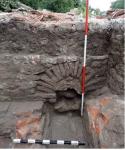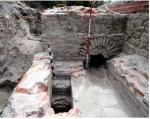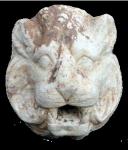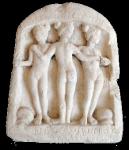Summary (English)
DIOCLETIANOPOLIS (Mitko Madzharov – m_madjarov@abv.bg, Dimitrinka Tancheva) A square structure built of stones and bricks bonded with mortar was explored to the east of Room No. 1 (caldarium). The structure had a barrel-vaulted passage which accommodated terracotta pipes that provided cold water for cooling the warm mineral water in the large pool of the caldarium. A shaft with seven steps that lead towards a platform with a long underground gallery was discovered in the southern part of the structure. Part of a water-conduit of terracotta pipes was discovered from the eastern side of the thermae and cardo maximus was situated to the northeast of it. The main water-conduit which supplied cold water for the Roman town was situated there. The distribution shaft which supplied cold water for the thermae was also documented. A drain constructed of bricks was discovered in the anteroom of Room No. 04 which served to drain the water from pool. A marble spout of a fountain in the shape of a lion’s head and a marble foot from a statue were found in the eastern end of the drain. A marble votive relief of the Three Nymphs of the middle of the 2nd century AD was discovered from the southern side of the caldarium. It had a votive Greek inscription which called the nymphs “dryads” and gave the name of the dedicator: Severus (son) of Amonius, who probably was of Egyptian origins. A number of votive reliefs and altars with dedicatory inscriptions to the nymphs of the second half of the 2nd – 3rd centuries AD were discovered in the Roman town. In that time a nymphaeum existed close to the mineral springs.
- Mitko Madzharov - Archaeological Museum – Hisar
- Dimitrinka Tancheva - Archaeological Museum – Hisar
Director
Team
Research Body
- Archaeological Museum – Hisar






![Download [PDF]](/excavation/skins/fasti/images/results/download_sml.png)



